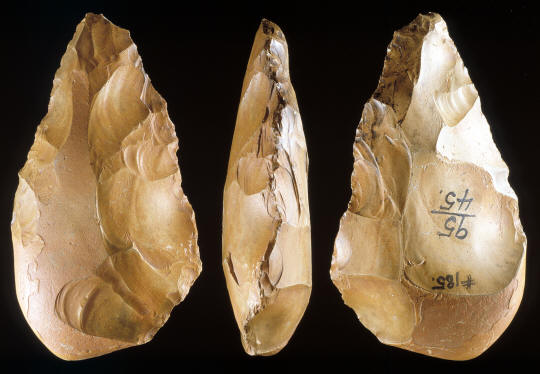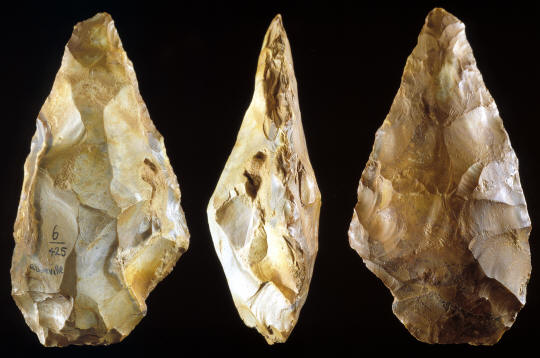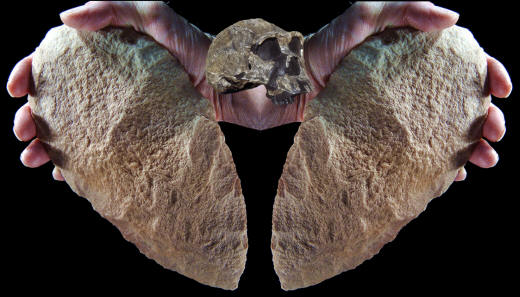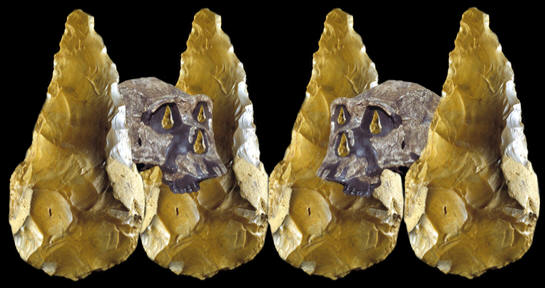|
"Based originally
on numerous handaxes discovered at the site of St. Acheul (France),
the term Acheulean is applied to stone assemblages with large bifacially
flaked, ovoid tools (handaxes)."---1988,
Ian Tattersall, Eric Delson & John Van Couvering, "Encyclopedia of Human
Evolution and Prehistory," Acheulean, p. 3.
"Along
with cleavers this artifact type (handaxes)
represents the first definite, deliberately stylized form of artifact in
prehistory."---1988, Ian Tattersall, Eric
Delson & John Van Couvering, "Encyclopedia of Human Evolution and
Prehistory," Handaxe, p. 241.
"These (handaxes)
were made and used for tens of thousands of generations of hominids over
much of the inhabited world. But the secrets of their importance have
all but died with their makers"---1993,
Kathy D. Schick and Nicholas Toth, "Making Silent Stone Speak,"
What Were Acheulean Tools Used For?, p. 258.
"At much the same time as Homo erectus appears on
the African scene there also appears a new bifacial technique for making
stone tools, and we find the first characteristic tools of the Middle
Pleistocene: the handaxe and cleaver."---1971,
J. Desmond Clark, "The Horizon History Of Africa," African
Beginnings, p. 26.
"Today, the most commonly used term for these
objects (handaxes)
is "biface," because of its lack of any functional connotations." ---1994,
Andre Debenath and Harold L. Dibble, "Handbook Of Paleolithic Typology,
Vol. 1," Bifaces and Cleavers, p. 130.
"Handaxes, widely regarded as the hallmark of the
Acheulean, are large cutting tools, with various carefully fashioned
planforms, the commonest being oval, pear-shaped, lanceolate, and
triangular."---1996,
Brian M. Fagan, "The Oxford Companion To Archaeology,"
Acheulean Tradition, p. 1.

ACHEULEAN HANDAXES
EST. 1.5 MILLION TO
90,000 YEARS AGO
The Early Paleolithic period produced, by weight, most of the stone
tools that were ever made. They were made in astonishing numbers for 2.7
million years. What is most remarkable is that the majority of them were
made by several different species of hominids.
The production of handaxes first appears
in Africa approximately 1.5 million years ago with the emergence of a
new hominid type, Homo erectus.
|
|

CLICK ON
PICTURE FOR LARGER IMAGE
ACHEULEAN HANDAXES
PALEOLITHIC PERIOD
FRANCE, GREAT
BRITAIN AND AFRICA
EST. 750,000
TO 90,000 YEARS AGO
AMERICAN MUSEUM OF NATURAL
HISTORY,
UNIVERSITY OF CALIFORNIA-
BERKELEY-DEPARTMENT OF ANTHROPOLOGY, CRAFT RESEARCH CENTER-
INDIANA UNIVERSITY, SMITHSONIAN INSTITUTION AND PRIVATE COLLECTIONS
These seventeen handaxes illustrate a few of the many different
shapes and types of Acheulean bifaces that have been discovered on
sites in several different countries on two continents. An estimated
range of time for these bifaces is somewhere between 750,000 and
100,000 years ago. Acheulean handaxes and cleavers are the first
definite, deliberately stylized form of artifact in prehistory.
This picture illustrates handaxes from the Kalambo Falls site in
Zambia (two large pink quartzite examples,
bottom row), the St. Acheul site
near Amiens in northern France (green oval
at 2nd row left & pointed green example top center),
Abbeville in northwestern France (top row
2nd from left, bottom example),
Egypt near Thebes near the Nile River (top
row 5th from left, orange),
Romsey, England, etc.
These handaxes were made from several different grades of chert,
quartzite and basalt. They range in size from5 3/16 inches (13.1 cm)
to 9 1/2
inches (24.1 cm) long. |
|
|
The Acheulean stone tool tradition is represented by Homo erectus.
The most recognizable tool type made during this period are the
handaxes. In fact, handaxes and cleavers are the first definite,
deliberately stylized form of artifact in prehistory. Most of the
handaxes made during this early period were made by Homo erectus but
Mousterian stone tool assemblages, represented by Neanderthals, also
produced handaxes possibly as early as 150,000 years ago. The Mousterian
handaxes are generally smaller. All the handaxes in this article are
believed to be
Acheulean. |
|

CLICK ON
PICTURE FOR LARGE TRIPLE IMAGE
HANDAXE
ACHEULEAN
THEBES, EGYPT
EST. 250,000
TO 90,000 YEARS AGO
AMERICAN MUSEUM OF NATURAL
HISTORY COLLECTION
This handaxe was collected on the surface near Thebes in southern
Egypt near the Nile River.
Jim G. Shaffer, PhD. describes this handaxe as: "A good
example of an "almond" shaped biface. Presence of cortex areas (the
dull granular surface) on the base and the short, broad and deep
flake removal scars (for example the area where the black numbers
are painted) in conjunction with the thick base suggest that this
example represents an early stage (Abbevillian/Chellean) of biface
technology. At the same time the presence of relatively long, narrow
and flat removal scars near the pointed end and occasionally along
the lateral edges suggest a soft-hammer was used to retouch or
sharpen the artifact after utilization. This soft-hammer technique
indicates that it is not representative of the very earliest stages
of biface technology. Numerous small, deep flake scars along the
lateral edges indicates extensive and heavy utilization of the tool.
The semi-polished appearance of the tool and the soft, rounded edges
of the flake scars probably reflect the abrasive actions of wind
blown desert sand."
This handaxe is made of a light reddish brown flint and it measures
6 15/16 inches (17.3 cm) long, 3 1/4 inches (9.5 cm) wide and 1
11/16 inches (4.2 cm) thick. |
|
|
Some of the earliest handaxes discovered to date have been found in
Africa in Tanzania and Ethiopia. The most famous site is Middle Bed II
at Olduvai Gorge in Tanzania. The Acheulean Tradition appears quite
suddenly after over a million years of the Oldowan Tradition that
produced very simple flake and pebble tools. |
|

CLICK ON PICTURE FOR LARGE TRIPLE IMAGE
HANDAXE
ACHEULEAN
ABBEVILLE,
FRANCE
EST. 600,000
to 500,000 YEARS AGO
AMERICAN MUSEUM OF NATURAL
HISTORY COLLECTION
This handaxe was found at Abbeville in northwestern France near the
Somme River. It represents a very early stage of biface technology.
It was made with the use of a hard-hammer using a stone as a hammer.
Later handaxes began to be made with softer hammers made of
either antler, bone, ivory or wood
Jim G. Shaffer, PhD. describes this handaxe as: "An example of an "Almon"
shaped biface. Presence of small cortex areas (the pitted areas on
the thick side of the artifact), large flake removal scars, and
thick cross-section indicate it was manufactured with a hard
hammerstone representing an early stage in biface technology. The
continuous and sinuous cutting edge around the periphery of the
artifact is characterized, especially along one side and the base,
by numerous small and deep flake removal scars suggesting relatively
heavy utilization and/or attempts to thin the artifact."
This handaxe is made of light brown flint and it measures 5 3/16
inches (13.1 cm) long, 2 5/8 inches (6.7 cm) wide and 1 3/4 inches
(4.4 cm) thick. |
|
|
Acheulean handaxes are found over a wide area in many countries and
continents. They originate in Africa where they extend northward to
Europe and the Middle East and as far east as India. |
|
CONTINUE ON TO PAGE
TWO
|
|
"REFERENCES"
1961, Braidwood, Robert J., "Prehistoric Men," Flake
Tools, p. 45.
1971, Clark, J. Desmond, "The Horizon History Of Africa," African
Beginnings, p. 26.
1988, Tattersall, Ian, Delson, Eric & Couvering, John Van,
"Encyclopedia of Human Evolution and Prehistory," Acheulean and
Handaxe, pp. 3 & 241.
1993, Schick, Kathy D. and Toth, Nicholas, "Making Silent Stone
Speak,"
How Were Handaxes And Cleavers Made?,
What Were Acheulean Tools Used For?, pp. 238 & 258-259.
1994, Debenath, Andre and Dibble, Harold L., "Handbook Of
Paleolithic Typology, Vol. 1," Bifaces and Cleavers, pp. 130-171.
1996, Fagan, Brian M., "The Oxford Companion To Archaeology,"
Acheulean Tradition, p. 1.
Personal Communication with Jim G. Shaffer, PhD., Case Western Reserve.
|
|
RECENT
LISTINGS HOME
ORDERING |





